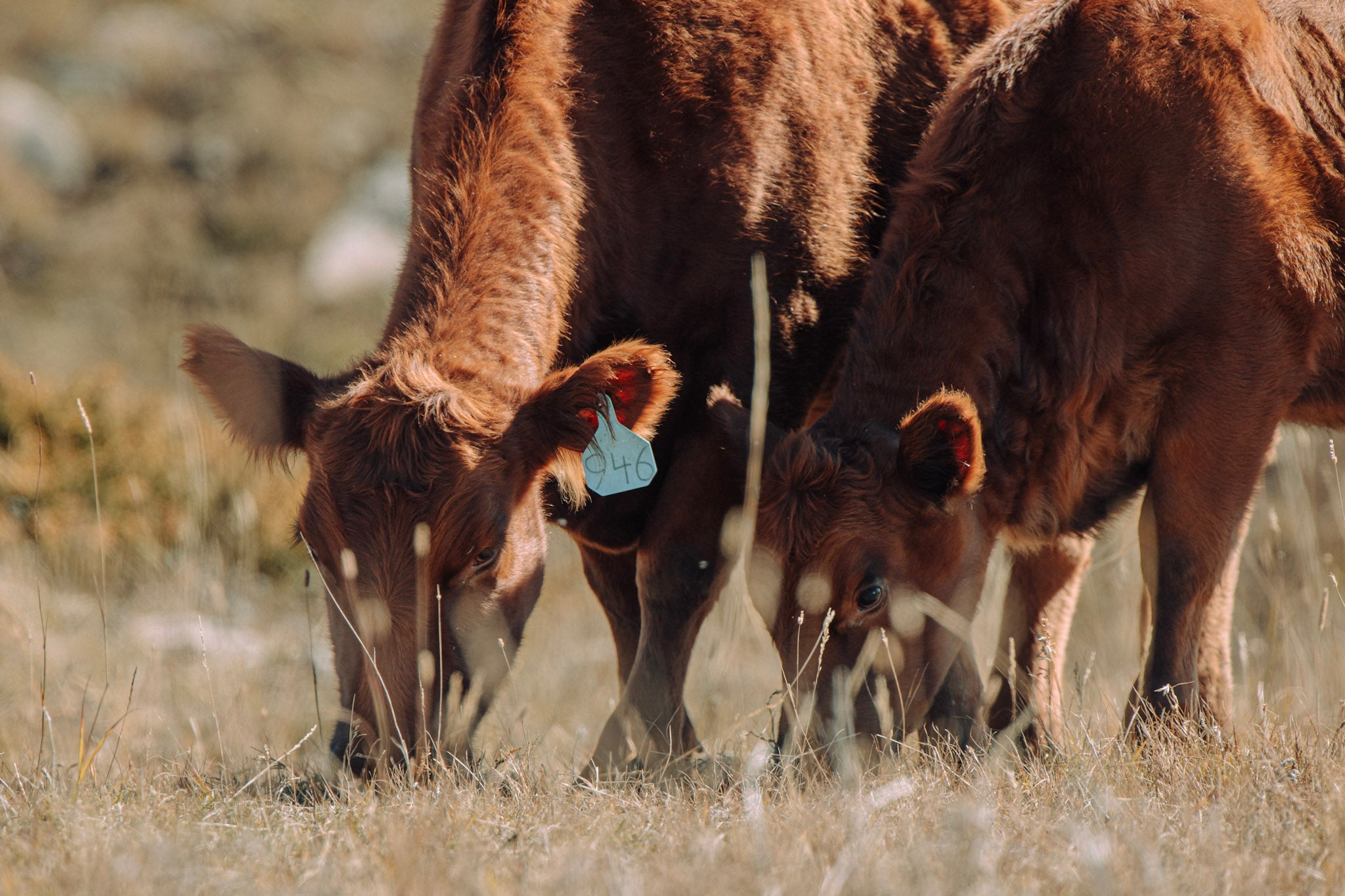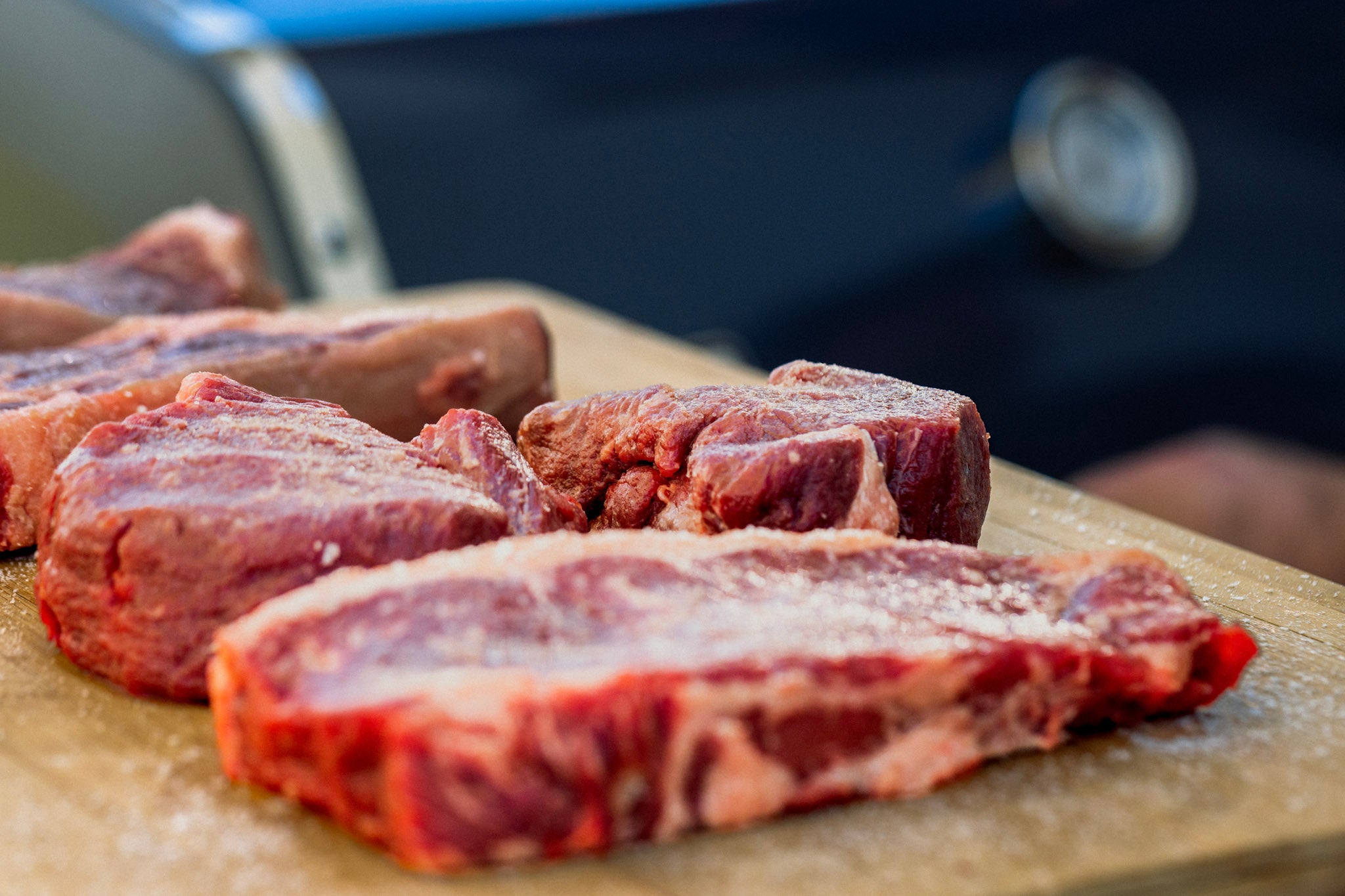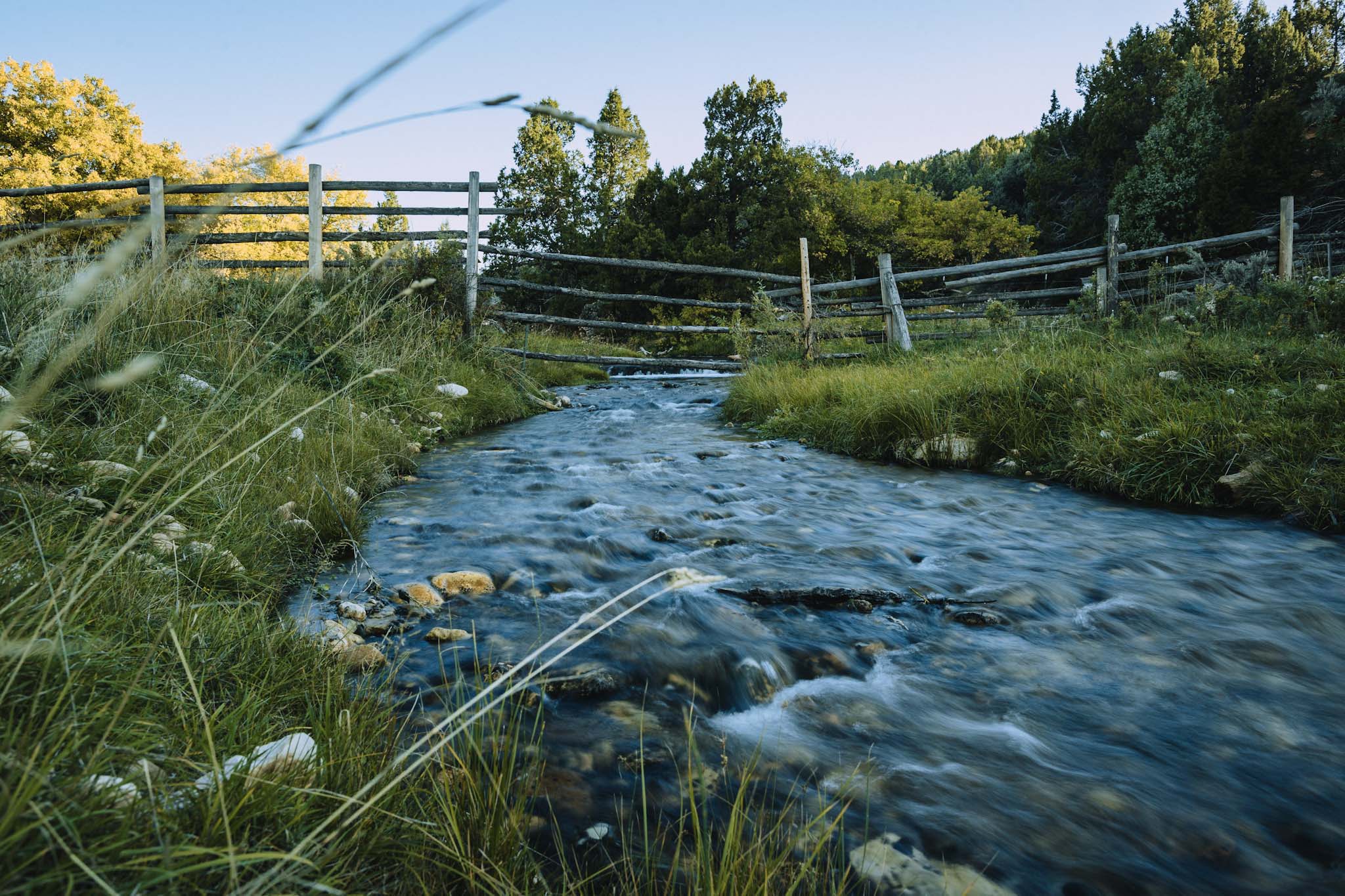
Cattle Feedlots: What Are They and How Do They Work?
A feedlot is an area or building where livestock are fattened up for—you guessed it—harvest, which is the kinder word for animal-becomes-meat-in-the-freezer. People have various opinions about feedlots, mostly regarding environmental impact, animal health, and grain-versus-grass finish. This article aims to provide a comprehensive (and simple) look at cattle feedlots in relation to beef production and quality.
What is the primary purpose of cattle feedlots in the beef production process?
Cattle feedlots work to increase the amount of fat gained by each animal as quickly as possible. Since the cattle are confined to a specific area (instead of grazing over grassland), they expel less energy and gain more weight—and fast!
To yield high-quality beef, cattle need to have the proper ratio of fat to muscle. If cattle are too lean, their meat will lack flavor and tenderness.
Fat does wonders for beef, and finishing feed does wonders for fat.
Most cattle spend their lives eating grass, making them (technically) grass-fed beef. However, when cattle are shipped to feedlots in the final stages of the beef production process, they’re usually given a grain-based finishing feed. This rich feed allows them to gain the proper amount of fat within a couple of months. So, for the most part, conventional cattle (97% of them) are grass-fed and grain-finished.
Some people opt for grass-finished beef, thinking grain-finished offers less health benefits, which isn’t the case. Grain-based finishing feed has two purposes: (1) to help cattle gain weight and (2) to give the beef a more robust flavor, neither of which grass can do.
Grain does not mean bad for you. It only means rich, buttery beef. To better understand this, look at how finishing feed affects beef quality.
As stated above, fat does wonders for beef, and finishing feed does wonders for fat. The two go hand in hand. Not only does finishing feed promote weight gain, but it gives the fat most of its flavor.
Here at Lazy T Ranch, when asked about beef quality, our cow boss said that even though our cattle spend their lives grazing on grass, the beef’s taste comes mainly from the finishing feed.
Finishing isn’t a new concept. Take whiskey for example. After malting, the grain is mashed, fermented, and distilled into whiskey. Then, the whiskey is aged in wooden containers, usually barrels. The wood affects the whiskey’s flavor, aroma, color, and overall experience.
Think of cattle feedlots and finishing feed as the “wooden barrel” for beef. As cattle eat the grain, they fatten up, and that fat takes on a delicious flavor inspired by the grain.
Sidenote: Cattle feedlots do more than finish cattle for slaughter. The feedlot sector also works to either grow or fatten calves until they reach slaughter weight.
In the growing phase, otherwise known as backgrounding, a feedlot works to grow calves at the desired speed, usually within the first 90 days after arrival. The high-forage-low-grain feed is designed to maximize growth and minimize fat deposition.
The finishing phase includes the 100 days after backgrounding. It focuses on feeding high-grain-low-forage rations to backgrounded calves or yearlings until they reach a prescribed finish (fat cover) before marketing for slaughter.
For the sake of this article, let’s focus on feedlots in relation to finishing adult cattle.
What are the key components of feedlot operations?
Feedlots are the final stage of cattle production. They provide a confined area for feeding steers and heifers a mix of grain, silage, hay, and protein supplement. The goal is to produce beef that will meet the USDA quality grade Select or better for the slaughter market.
Depending on the cattle’s weight at feedlot placement, along with feeding conditions and desired grade, the feedlot period can be anywhere from 90 to 300 days. The average weight gain is between 2.5 and 4 pounds per day on a diet ratio of 6 pounds of dry-matter feed per 1 pound of gain.
(Not only is the United States the world’s largest consumer of beef, but it has the world’s largest fed-cattle industry. U.S. feedlot operations range in size. Those with less than 1,000 heads of cattle are most common, but they serve a small share of the market. Those with 1,000 or more heads of cattle make up only 5% of total feedlots. However, they serve 80 to 85% of the fed cattle market.)
There are two types of feedlots—outdoor and indoor. Outdoor feedlots do best in drier climates. Indoor feedlots protect the cattle from harsh weather and keep feed and bedding dry. Generally, indoor feedlots are much smaller than outdoor and hold few cattle per pen but at higher stocking density.
Both outdoor and indoor feedlots typically have processing barns for handling cattle. These barns contain holding pens, a tub, and a chute, either curved or straight that leads to a squeeze chute. In the squeeze chute, cattle can safely receive vaccinations and other medical treatments.
Simplifying operations:
- Cattle are placed in a confined area and given high-grain-low-forage feed.
- They’re monitored for the duration of their stay and given proper medical care.
- Once they reach the desired finish (fat cover), they are marketed for slaughter.
What feeding techniques and nutrition strategies are commonly employed in feedlots?
The feed-to-gain ratio (F: G), also known as the feed conversion ratio, is how feedlots measure efficiency. It focuses on cattle’s ability to convert feed into body mass. F: G plays a huge role when determining the cost to finish an animal. For example, steers fed grain diets grow faster, finish sooner, and produce heavier, fattier carcasses. This means higher efficiency and less overall costs.
The type and quality of grains, as well as the balance of essential nutrients (vitamins, proteins, trace minerals), significantly impact efficiency. Balanced feed increases average daily gain and can decrease feed cost per pound of gain.
Cattle feedlots also focus on digestibility. Grains like corn, barley, and oats are easier to digest when processed. By cracking the outer shell of the grain, rumen microbes are better able to utilize grain starch and minerals. Along with that, processing allows grains to be mixed with supplements and makes the grains easier to chew and swallow.
Growth promotants, such as ionophores and beta-agonists, are used by feedlots to raise beef efficiently, all while maintaining high standards of animal health, meat quality, and food safety.
Ionophores are antimicrobials delivered through cattle feed. They improve nutrient availability, feed efficiency, and weight gain. They also reduce methane production, lower the risk of bloat and acidosis, and prevent diseases.
What are the benefits and challenges associated with using cattle feedlots?
Feedlots are a necessary step in cattle production. Although challenges often include high costs and choosing the most effective feed program, cattle feedlots provide an opportunity to control (and monitor) weight gain and produce consistent, high-quality graded beef.
At Lazy T Ranch, the rolling Wyoming grasslands aren't just our backdrop—they're our pride. Each blade nurtures our cattle, reflecting our commitment to premium quality beef. Our partnership with a top-tier feedlot operation ensures that both taste and animal welfare are paramount. Experience the essence of our ranch with every bite. Try our dry-aged beef boxes and savor the Lazy T difference today.


